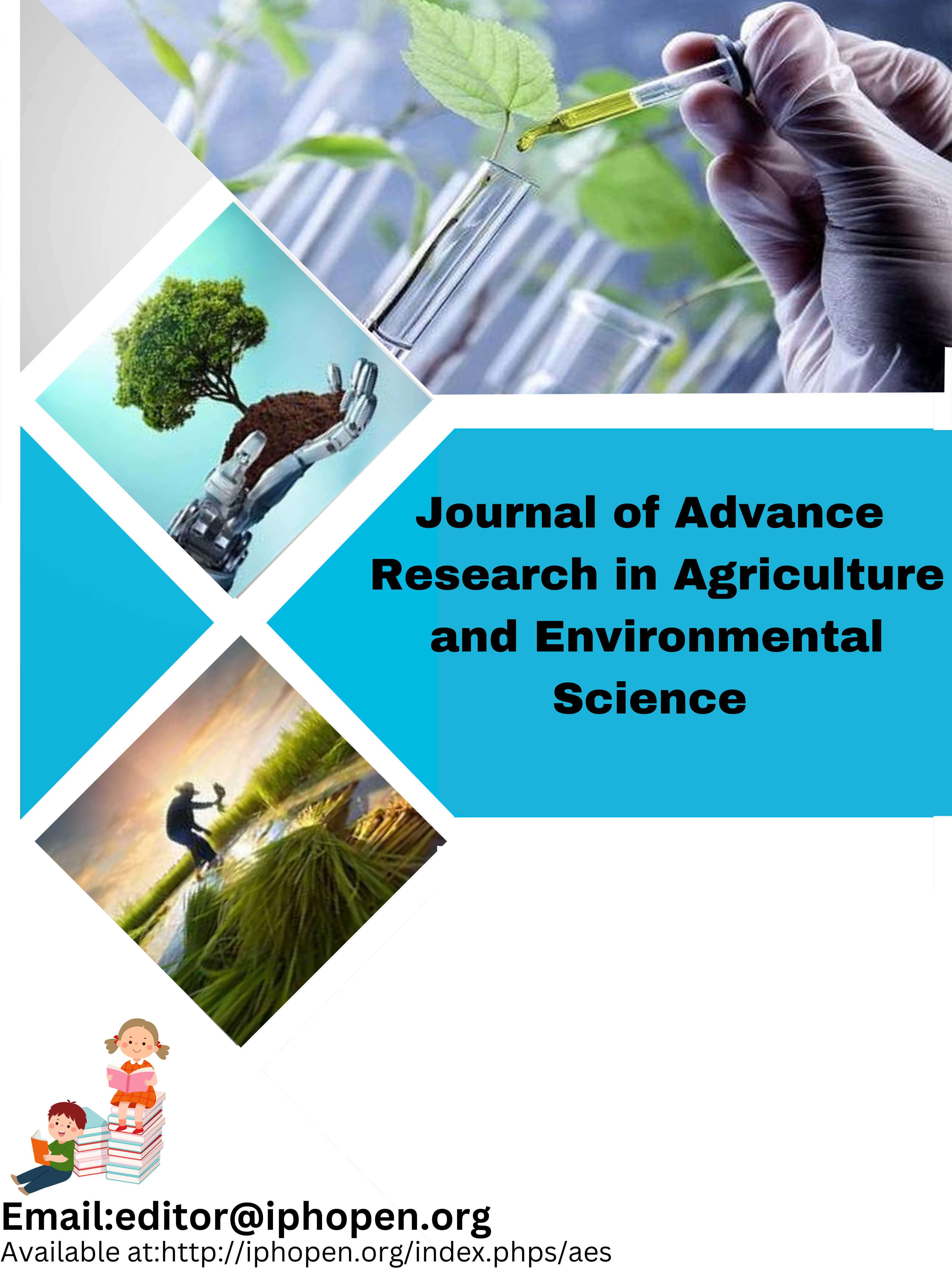Effect of Feeding Unpeeled Cassava mash as Substitute for Maize in Layers diet on Growth and Egg Production Performances.
DOI:
https://doi.org/10.5281/zenodo.13382184Keywords:
Unpeeled, peeled, cassava, mash, maize, performance, growthAbstract
The study assessed the growth and egg production performances of laying birds fed varying levels of unpeeled cassava mash as substitute for maize. One hundred and fifty (150) birds that were thirty four (34) weeks old were randomly allocated to five dietary treatment of 30 birds each replicated twice with fifteen birds per replicate. The experiment lasted for 10 weeks, unpeeled cassava mash was used at 0%, 25%, 50%, 100% and peeled at 25% in replacement of maize. The proximate analysis of the experimental diets revealed there were similarities in the composition as regards Ether Extracts (EE), Nitrogen Free Extract (NFE), calcium and phosphorous. Also, proximate analysis of cassava mash revealed that crude protein (CP)) Ether Extract (EE), Ash and Cyanide percentage of untreated cassava are greater than peeled but NFE of peeled cassava was greater than unpeeled. Results of performance of birds revealed significant (P<0.05) difference in feed intake but feed conversion (FCR) was not affected by dietary treatment. Hen day production significantly (P<0.05) differs, while egg weight was not significantly affected. It was concluded that 25%, 50% and 100% inclusion levels of unpeeled cassava mash can compete effectively well with 100% maize based diet in supporting egg production and performance and can therefore be used where it is found to be cheaper than maize.
References
Oluyemi, J.A.and Robert, F.A.(2013).Poultry Production in Warm Wet Climate Macmillian Publishers,London and Basingstoke pp.197.
Abeke. F.O.,Ogundipe, S.O., Sekoni, A.A., Dafwang, I.T. and Oladele, S.B. (2003).Effectof Duration of Cooking ofLab-lab Beans on Organ Weight and BloodParametersof Pullet chicks. Procedure of 28th
annual NSAP conference, Ibadan,28:240-242.
Bawa, G.S., Tegbe,T.S.B. and Ogundipe, S.O. (2003). Effect of Feeding Graded Dietary Levels of Lablab seeds as replacement for Soya beans on performance characteristics of young pigs. Proceeding of the 28th annual NSA conference.
Aduku,A.O.(2004). Animal Nutrition in the Tropics Feeds and Feeding Posture Management Monogastric and Ruminant Nutrition. Davcofl Business Bureau. 11 Baptist Chruch Road, Samaru Zaria, Kaduna State.
Yisa, A.G., Edache, I.A., Atam, S.K.and Samuel, S.M.(2010). Carcass yield of finishing Cockrels fed graded levels of boiled Pigeon Pea (Cajanus Cajan (-) millsp).Proceeding of 44thAnnual Conference of the
Agricultural Society of Nigeria, Ladoke Akintola University of Technology, Ogbomoso, 658-660.
Owosibo, A.O., Omole, A.J., Fapounda,J.B.and Fasanmi,O.G.(2007). Small and Medium Scale Egg Production Manual Green Choice Agric Publications.
Stadelman,W.J.(2016). The preservation of quality in shell Eggs. In: Stadelman, W.J and Cotlerill, O.J (Eds). Egg Science and Technology Ari publishing com, Inc., West port Connecticut, U.S.A.
Taraba State Official Diary (TRSD 2008)
Tewe, O.O. (1994). Indices of cassava safety for livestock feeding: Being Paper in International ACTA Horticulture Workshop on Cassava Safety. IITA Ibadan Pg. 241-248.
Tewe, O.O., Kasali, O.B.N. (1982). Effect of cassava peel processing on the nutrient utilization and physiopathology of the African giant rat (Cricetomus gambianus). Water house tropical agriculture.Trinidad. 63(2): 125-128.
Salami, R.I. and Odunsi, A.A. (2003). Evaluation of processed cassava peel meals as substitutes for maize in the diets of layers. International Journal of Poultry Science, volume 2, issue 2, pp. 112-116.
Anaeto, M., Sawyerr, A.F., Alli, T.R., Tayo, G.O., Adeyeye, J.A. and Olarinmoye, A.O. (2013). Cassava leaf silage and cassava peel as dry season feed for West African dwarf sheep. Global Journal of Science Frontier Research Agriculture Veterinary Science, 13(2), 1-4.
Akinfala,E.O., Aderibigbe, A.O., Mantanmi, O. (2002). Evaluation of the Nutritive Value of whole cassava plant as replacement for maize in thestarter diets for broiler chicken. Livestock Resources Rural Development. 14, 1-6.
AOAC (2010). Official methodsof Analysis of Association of Official AnalyticalChemists. 18th Edition,Washington, D.C.
Duncan, D.B.(1955). Multiple range and multiple F-tests. Biometrics 11:1-42
SAS (2009).SAS User’s Guide, version 9.1 for windows statistical Analysis systems institute, Inc., Cery,NC, USA.
Tewe, O.O., Job, T.A., Loosli,J.K.and Oyenuga, V.A.(2016). Composition of two local cassava varieties and the effect of processing on their hydrocyanic content and nutrient utilization by the rat. Nigerian Journal of Animal Production 3 (2) 60-66.
Smith, O.B.(2002). A review of ruminant responses to cassava based diets. In proceeding of the IITA /ILCA University ofIbadan Workshop on the potential utilization of cassava as a livestock feed in Africa.IITA, Ibadan, Nov. 14-18.
Smith, A.(2001). Poultryin the TropicsAgriculturalist Centre for Tropical Veterinary Medicine University of Edinburg U.K.C.T.A Publication. Mac million Education LTD, London and Oxford Second (revised)Edition.
Kenelly,J.J.and Aheme, F.X.(2008). The effect of fibre in diets formulated to certain different levels of energy and protein on digestibility coefficient in swine.Canadian Journal of Animal Science 60:7 17-726.
Raid, B.L.and Maiorino, P.M.(2008). Interaction of dietary metabolizable energy protein in laying hens diets poultry science 59 (4) 1450-1454.
Patrick, H.and Schalle, P.J.(2008). Poultry: Feeding and Nutrient 2ndEdition. Avi Publishing Company Inc Westport Connection Pp. 257-265.
Brake, J.D.and Peebles, E.D.(2002). Laying hen performance as affected by diet and capingdensity.Poultry Science. 71 (Suppel 1) 945-950.
Church, D.C.(1991). LivestockFeeds and Feeding 3rd Edition Prentice-hall, Inc. ADivisionis Simon and Schuster, EnglewoodCliffs, New Jersey.
Mahadi, A.(2002). PoultIy Production in Nigeria OpeningAddress at NationalTraining Workshop on Poultry Production in Nigeria. A Training Manual 1st–6thSeptember. Shika National Animal Production
Research Institute, A.B.U Zaria,
Downloads
Published
How to Cite
Issue
Section
License
Copyright (c) 2024 IPHO-Journal of Advance Research in Agriculture and Environmental Science

This work is licensed under a Creative Commons Attribution-NonCommercial-ShareAlike 4.0 International License.
Author(s) and co-author(s) jointly and severally represent and warrant that the Article is original with the author(s) and does not infringe any copyright or violate any other right of any third parties and that the Article has not been published elsewhere. Author(s) agree to the terms that the IPHO Journal will have the full right to remove the published article on any misconduct found in the published article.











